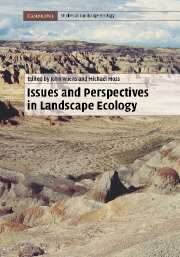Book contents
- Frontmatter
- Contents
- List of contributors
- Preface
- PART I Introductory perspectives
- PART II Theory, experiments, and models in landscape ecology
- 3 Theory in landscape ecology
- 4 Hierarchy theory and the landscape … level? or, Words do matter
- 5 Equilibrium versus non-equilibrium landscapes
- 6 Disturbances and landscapes: the little things count
- 7 Scale and an organism-centric focus for studying interspecific interactions in landscapes
- 8 The role of experiments in landscape ecology
- 9 Spatial modeling in landscape ecology
- 10 The promise of landscape modeling: successes, failures, and evolution
- PART III Landscape patterns
- PART IV Landscape dynamics on multiple scales
- PART V Applications of landscape ecology
- PART VI Cultural perspectives and landscape planning
- PART VII Retrospect and prospect
- Index
- Plate section
- References
5 - Equilibrium versus non-equilibrium landscapes
from PART II - Theory, experiments, and models in landscape ecology
Published online by Cambridge University Press: 20 November 2009
- Frontmatter
- Contents
- List of contributors
- Preface
- PART I Introductory perspectives
- PART II Theory, experiments, and models in landscape ecology
- 3 Theory in landscape ecology
- 4 Hierarchy theory and the landscape … level? or, Words do matter
- 5 Equilibrium versus non-equilibrium landscapes
- 6 Disturbances and landscapes: the little things count
- 7 Scale and an organism-centric focus for studying interspecific interactions in landscapes
- 8 The role of experiments in landscape ecology
- 9 Spatial modeling in landscape ecology
- 10 The promise of landscape modeling: successes, failures, and evolution
- PART III Landscape patterns
- PART IV Landscape dynamics on multiple scales
- PART V Applications of landscape ecology
- PART VI Cultural perspectives and landscape planning
- PART VII Retrospect and prospect
- Index
- Plate section
- References
Summary
Landscapes have a spatial domain that can be relatively large or small with respect to their disturbance regime. The ratio of typical disturbance size and landscape spatial extent characterizes the overall landscape behavior as well as the relative predictability of this behavior. Large-scale environmental change, human land-use changes, and natural or human-induced changes in the climate can all alter the spatial and temporal domain of the disturbance, and thus change the degree to which one can predict a landscape's dynamic behavior.
Conceptual considerations
When disturbances are sufficiently small or frequent, they are incorporated into the environment of the ecosystem; when they are sufficiently large and infrequent, they are catastrophic (Fig. 5.1A). There is an intermediate scale of extent and occurrence at which disturbance enforces a mosaic pattern to the ecological landscape. In this case, the landscape pattern is a mosaic of patches – each patch with an internal homogeneity of recent disturbance history different from the surrounding patches.
The mosaic landscape is a statistical assemblage of patches. As in any sampled system, when the number of such patches is small, the variability is relatively large with related increased unpredictability (Fig. 5.1B). If the number of patches making up a landscape is large, the landscape dynamics will become more predictable. Climate change and human land-use changes tend to increase the size and synchronization of disturbances and make landscape dynamics less predictable (Fig. 5.1B).
- Type
- Chapter
- Information
- Issues and Perspectives in Landscape Ecology , pp. 36 - 41Publisher: Cambridge University PressPrint publication year: 2005
References
- 3
- Cited by



